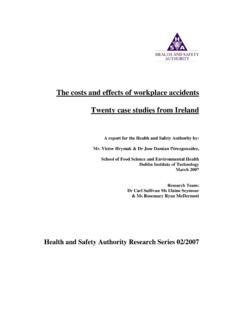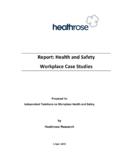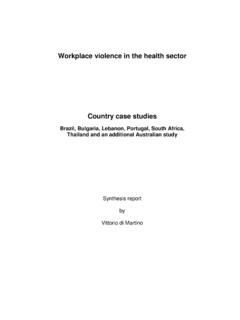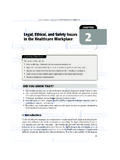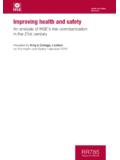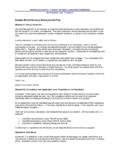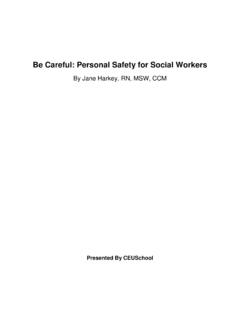Transcription of RESEARCH REPORT 262 - Health and Safety Executive
1 HSE Health & Safety Executive Health and Safety of homeworkers: Good practice case studies Prepared by the Health and Safety Laboratory for the Health and Safety Executive 2004 RESEARCH REPORT 262 HSE Health & Safety Executive Health and Safety of homeworkers: Good practice case studies Rachel O Hara, Julian Williamson, Alison Collins, Danny Higginson Health and Safety Laboratory Broad Lane Sheffield S3 7HQ Health and Safety Executive (HSE) guidance on homeworking has been in existence since 1996. However, findings from a study conducted by the Health and Safety Laboratory (HSL) (O Hara, 2002) indicate that both homeworkers and employers have not seen the guidance and are not familiar with Health and Safety legislation relevant to homeworking. HSE has stated that the existing homeworking guidance is now due for revision (Dempsey, 2001).
2 The aim of this project was to provide case study examples of good practice in addressing Health and Safety issues, which could be incorporated into any revision of the HSE guidance on homeworking. This REPORT and the work it describes were funded by the Health and Safety Executive (HSE). Its contents, including any opinions and/or conclusions expressed, are those of the authors alone and do not necessarily reflect HSE policy. HSE BOOKS Crown copyright 2004 First published 2004 ISBN 0 7176 2888 4 All rights reserved. No part of this publication may be reproduced, stored in a retrieval system, or transmitted in any form or by any means (electronic, mechanical, photocopying, recording or otherwise) without the prior written permission of the copyright owner. Applications for reproduction should be made in writing to: Licensing Division, Her Majesty's Stationery Office, St Clements House, 2-16 Colegate, Norwich NR3 1BQ or by e-mail to ii ACKNOWLEDGEMENTS The authors would like to thank the homeworkers and employers who participated in this RESEARCH .
3 We would also like to thank Clare McQuillan of Temple Consulting Ltd for her assistance in recruiting some of the employers. Thanks also to HSL colleagues Hannah White and Kathryn Shulver who assisted with different aspects of this work. iii iv CONTENTS 1 Introduction .. 1 2 Background .. 2 3 Method ..4 Identification of Recruitment of sample: homeworkers and employers ..4 Data collection: case study visits ..4 Analysis of 4 case studies ..6 Health and Safety law ..6 Textiles/Sewing:..6 Significant hazards and relevant Examples of Health and Safety for Packing/Assembly/Finishing:.. 17 Significant hazards and relevant Examples of Health and Safety for Electrical and Electronics:..33 Significant hazards and relevant Examples of Health and Safety for Business services/Working with Significant hazards and relevant Examples of Health and Safety for 5 Summary of good practice in managing the Health and Safety of homeworkers.
4 63 6 Appendices ..70 Appendix 1: Interview Appendix 2: Examples of Health and Safety Regulations relevant to homeworking ..71 Appendix 3: Template for Risk Assessment in Sewing/Textiles ..77 Appendix 4: Template for Risk Assessment in Packing/ Appendix 5: Template for Risk Assessment in electrical and electronics ..81 Appendix 6: Template for Risk Assessment in business services/working with 83 7 References ..85 v vi Executive SUMMARY Health and Safety Executive (HSE) guidance on homeworking has been in existence since 1996. However, findings from a study conducted by the Health and Safety Laboratory (HSL) (O Hara, 2002) indicate that both homeworkers and employers have not seen the guidance and are not familiar with Health and Safety legislation relevant to homeworking. HSE has stated that the existing homeworking guidance is now due for revision (Dempsey, 2001).
5 The aim of this project was to provide case study examples of good practice in addressing Health and Safety issues, which could be incorporated into any revision of the HSE guidance on homeworking. OBJECTIVES The objectives of the project were: - To obtain examples of good practice in addressing Health and Safety in homeworking from employers and homeworkers across four different sectors/activities. - To obtain information on any difficulties encountered in addressing Health and Safety for homeworkers and how these have been overcome. - To obtain information on the impact of any Health and Safety measures. - To supplement these examples of good practice (if necessary) with additional information on appropriate measures to reduce risk ( from relevant HSE guidance, information on Safety equipment, etc.). - To provide a written REPORT describing 12 comprehensive case studies , which illustrate good practice in addressing Health and Safety in homeworking across different sectors.
6 METHODOLOGY Using a semi-structured interview methodology, examples of good practice in addressing Health and Safety in homeworking were collected from four different industry sectors: textiles; packing/assembly/finishing; electrical & electronic; and business services and computing. In total, 12 organisations were visited, and 28 homeworkers were interviewed along with a range of owners, directors and Health and Safety managers. The key topics that were addressed in the interviews included: identifying hazards; who is at risk; what measures have been taken to reduce the risk; what information, training and equipment homeworkers have been provided with; impact on the Health and Safety of homeworkers; employers motivation to address Health and Safety and any difficulties encountered.
7 MAIN FINDINGS The findings from the 12 organisations visited reveal a range of examples of good practice in managing Health and Safety for homeworkers, which are consistent with published HSE guidance. The findings also reflect a fundamentally developmental process in achieving successful Health and Safety management for homeworkers, with participating organisations being at different stages of development. Many organisations, while having elements of good practice, also have scope for further development. vii A summary of good practice in Health and Safety management for homeworkers across all four industrial sectors addresses: Sources of Health and Safety Information, Communication, Risk Assessment, Equipment Provision and Maintenance, Organisation, Information, Training, Incident Reporting, Difficulties, and Benefits of Addressing Health and Safety for Homeworkers.
8 Key findings presented in this summary include: It is important that homeworkers have one or two key contacts within the organisation for maintaining regular communication. A number of companies had outwork co-ordinators specifically to deal with homeworkers. The identity of the outwork co-ordinator was reinforced by using their photograph on documentation and notice boards for homeworkers, as well as promoting the use of a dedicated telephone line and voice mail by which the outwork co-ordinator could be contacted. It is good practice to conduct risk assessments that are specific to each homeworker s work environment, and involve the homeworker in the process of identifying potential hazards. Companies that have carried out risk assessments for individual homeworkers have addressed a range of significant hazards in the home workplace ( electrical; manual handling; chemicals; ventilation; lone working/isolation), and include potential hazards that would not normally be found in a workplace such as pets.
9 Regular reviews of risk assessments should be carried out to ensure that there have been no significant changes. One organisation provides homeworkers with a home workplace inspection form to conduct their own risk assessment on a monthly basis. Similar reviews are also scheduled to be carried out on a three monthly basis by the homeworker s team leader. Risk assessments are also reviewed if the homeworker s circumstances change, such as pregnancy or a house move. Providing and maintaining work equipment can help to ensure that homeworkers work safely as well as efficiently. Many companies go beyond providing the essential work materials and tools required to do the job. Additional equipment includes: tables; chairs; desk lamps; circuit breakers; smoke detectors; machine guards; masks; gloves; and first aid kits.
10 A lot of emphasis is put on supplying information to homeworkers, but it is also important to supply information on managing homeworkers to line management. Types of information that are useful include: competencies involved; how to manage high levels of trust and low levels of control; how to empower staff to work independently; information to help line managers support homeworkers and avoid potential consequences of lone working such as stress or isolation; and the setting of clear goals. Any incidents affecting homeworkers need to be communicated to, and recorded by employers. This includes accidents and any near miss occurrences. One company provides its homeworkers with a diary to record their hours worked and any problems or near miss occurrences ( breaking needle). These homeworkers are also provided with a dangerous occurrence/near miss REPORT form and an accident REPORT form.










